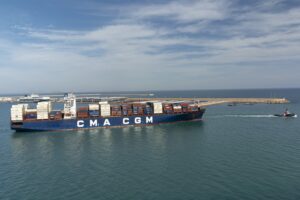
- The València Containerised Freight Index (VCFI) – which measures the performance and evolution of the cost of container transport by sea from the Valencian precinct – grew in December for the second time in 2023 to reach 1,239.93 points
- An increase of +4.66 is observed in the last month of the year which accumulates a growth since the beginning of the historical series in January 2018 of 23.99%
- Although not yet reflected in the index for the last month of the year, 2024 has started with a scenario of high volatility in freight rates due to the Red Sea Crisis and the recent attacks on merchant ships travelling through the Suez Canal
- As regards the Western Mediterranean sub-index, a decrease of -6.49%. Is observed while the Far East sub-index has recorded a drop of -9.64%
València, 12 January 2024.- Export freight rates from the Port of València grew for the second consecutive month and in December recorded an increase of +4.66%. This is reflected in the València Containerised Freight Index (VCFI) – which measures the trend and evolution of the freight rates of the Valencian precinct – and which in the month of December stands at 1,239.93 points – maintaining similar levels to those recorded during the second quarter of 2020. The VCFI accumulates a growth since the beginning of the historical series in January 2018 of 23.99%.
The Index also reflects a decrease in export freight rates from Valenciaport’s docks to the Far East area (-9.64%), which in November rose by +43.08%. Likewise, the Western Mediterranean sub-index also decreased: -6.49%.
Therefore, the VCFI at the end of 2023 does not yet reflect the variations caused by the Red Sea Crisis – the increase observed in it is marginal – and the high volatility in freight rates has started to become effective at the beginning of 2024.
In this sense, we must wait to see how the geopolitical conflict evolves in order to analyse its consequences in the medium term. After the numerous disruptive events of recent years – the crisis generated as a result of the pandemic or the consequences of the war in Ukraine – the Red Sea Crisis, which has been called the “perfect logistical storm”, is a burden for supply chains and, therefore, for the global economy.
The Suez Canal is one of the most important routes for the transport of consumer goods, oil and liquefied natural gas globally. In fact, the conflict has caused shipping companies to establish contingency plans to try to minimise the impact, opting to take an alternative shipping route via the Cape of Good Hope, which is much longer and more costly, causing some congestion and delays in deliveries.
VCFI Western Mediterranean
With regard to the Western Mediterranean sub-index, was observed in December with respect to the previous month a decrease of -6.49%, after three consecutive months of growth. Thus, the VCFI for the Western Mediterranean area stands at 1,447.90 points, representing an accumulated growth of 44.79% since the start of the series in 2018.
As far as Valenciaport is concerned, and according to the latest available data, an increase in the volume of exports to Morocco of +16.14% (compared to the previous month) has been observed. Exports to Tunisia have contracted by -36.40% and, as for Algeria, a significant increase of 84.21% has been observed.
VCFI Far East
In relation to the Far East area, a drop of -9.64% has been observed, reaching 1,096.39 points, which represents an accumulated growth of 9.64% since the beginning of the series in January 2018. With regard to Valenciaport’s traffic with this area, and based on the latest available information, an increase of 36.26% is observed with respect to the previous month. If you wish to read the full report, you can consult this link

